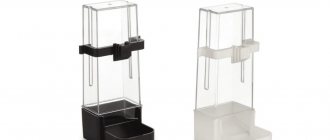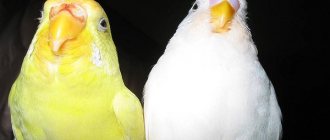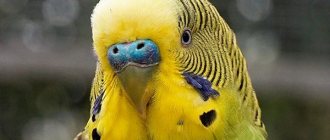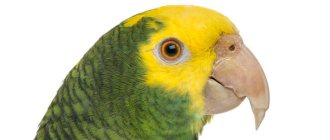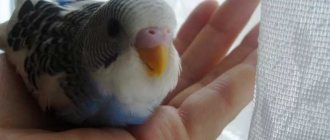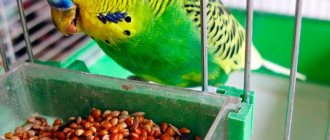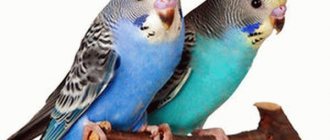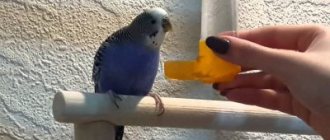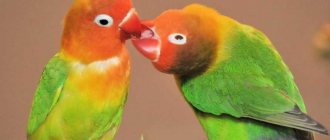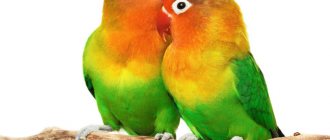Breeders have this question: how can you tell if a parrot is pregnant? Let's face it: pregnancy in a parrot is not a completely correct concept, since birds lay eggs and do not carry chicks in their stomachs. And yet there are periods in the life of females when they have a very interesting position. Let's look at the reproduction of budgies, learn about the process of hatching eggs, possible complications, and also see what a pregnant female budgie looks like.
Parrots mating
Male budgerigars reach sexual maturity at the age of 10 months, and females - after 1 year. From this moment they become able to lay eggs. If females are kept without males, they will lay unfertilized eggs. Birds do not incubate such clutches, and chicks do not hatch from them. In order for a female to lay fertilized eggs, she must mate with a male of her own species.
To produce offspring, a pair of breeders are placed in a separate cage with a nesting house installed inside. The diet of future parents is enriched with protein feeds, sprouted grains, vitamin and mineral supplements. If the couple is ready to reproduce, the male begins to court his partner, and she accepts the advances. In addition, the female begins to build a nest. Once this process is complete, the birds mate repeatedly. At the same time, the female raises her tail, and the male sits on top of her, opening his wings. Mating lasts 1-2 weeks, after which the parrot becomes pregnant.
Mating season
Budgerigars are very loyal birds. If a male chooses a mate, then you can be sure that this is the only “lady” in his life.
No one gives an exact date for the mating season. The mating season is the definition of the period of time that begins with the formation of a couple and ends with fertilization.
Anyone can notice the courtship of a male with a female; you don’t have to be an expert in bird matters. He will begin to fluff his feathers and show other signs of attention.
Having noticed this behavior in the male, you can safely begin to prepare a house for the couple. The female will immediately begin to show interest in him. It will be okay if she “tidies up” there. The male will begin to “show great initiative.” He can feed the female and present her with unique gifts. The behavior of the birds will also indicate that they are “declaring themselves a couple” - they will begin to huddle together and stroke the feathers with their beaks.
After the first mating, you should not expect offspring. Pregnancy of a budgerigar is possible only after regular mating.
How to tell if a female parrot is pregnant
Sometimes birds experience infertility, which can be caused by various reasons. In this case, the couple will mate, but pregnancy will not occur. Therefore, breeders who observe the mating of breeders, as a rule, strive to find out as soon as possible after the completion of this process that the female parrot is pregnant and can soon be expected to lay a clutch. To determine when this moment comes, you should carefully monitor the bird and note any changes in its behavior.
Signs of pregnancy in budgies include the following behavioral features:
- The female looks calmer, prefers to sit in one place and doze. She may spend more time performing routine procedures than before pregnancy.
- After successful fertilization, a pregnant female budgerigar stops allowing her partner to approach her. If breeders are kept in a common cage with other parrots, a pregnant individual may show aggression towards neighbors and drive them away from the nest. She also begins to avoid people.
- The female spends a lot of time in the nesting house, arranging the nest.
- The bird consumes more feed and defecates more often.
- Before laying eggs, the expectant mother tries to hide in a secluded place - in the corner of the cage or in the nesting house.
- Before laying eggs, the female has an area on her belly that is devoid of feathers - the so-called brood spot. The bird lines its nest with plucked feathers.
- The volume of the bird's abdomen increases, the cloaca turns red and swells.
- The tail sways in time with the bird's breathing.
Alternatively, pregnancy can be determined by gently palpating the bird's abdomen. The eggs will be palpable as rounded lumps.
Preparing for nesting
Parrots will safely bear and raise offspring if they carefully prepare paired birds, that is, those who have created a harmonious pair. Work begins almost a month before the expected laying:
- The season of the year is important for reproduction. It is better to organize nesting in the spring. Daylight hours are long enough, air temperature and humidity are optimal. A spring-summer variety of fresh food will benefit both older birds and young animals. Growing babies will have better conditions than winter chicks.
- The parrots are released to fly every day for a month. Active walks will strengthen muscles and speed up metabolism.
- At the same time, an intensive course of vitamin and mineral nutrition is started. Special preparations for birds are used, preferably recommended by a veterinarian or an experienced breeder.
- In the last week before mating, the diet is enriched with additional protein and sprouted grains.
- Departures from the cage are completely cancelled. They try not to disturb the birds.
- The nest box is hung. A parrot house should be spacious enough to accommodate a bird with grown chicks. At the bottom there is a small depression for eggs. The top cover is hinged. The optimal material is wood. The box is hung outside the cage. The entrance is combined with a side door so that birds can freely climb inside.
- If the birds are interested in the house, then mating has taken place and the female parrot is pregnant. How to understand that laying will begin soon? There is a little more than a week left until the X-hour. This will be indicated by behavioral and physiological signs that even a novice breeder will notice.
- As soon as the first egg appears, the amount of protein in the diet is reduced. The amount of succulent feed is gradually reduced. While the female lays and incubates eggs, she is fed only grain mixture or steamed porridge, so as not to provoke diarrhea. Feeding is gradually brought back to normal only before the first chick flies from the nest.
Possible complications
Problems directly during pregnancy in birds rarely occur. Complications associated with the egg laying process, such as dystocia, are much more common. It is expressed in the fact that the bird cannot lay an egg on its own. The causes of dystocia can be:
- small size of the female (due to too early admission to breeding);
- improper feeding of the female during the period of preparation for reproduction (lack of protein, vitamins and calcium in the diet);
- the egg is too large or irregularly shaped;
- torsion of the oviduct;
- dehydration or illness.
With dystocia, a pregnant budgie sits in one place for a long time, strains, and breathes heavily. A large lump is felt in front of the cloaca; The cloaca may be slightly open, and the shell is visible in its lumen. Long-term compression of the nerves can cause lameness.
Important! If signs of dystocia appear, you should seek help from a veterinarian. Without proper diagnosis and treatment, the bird may die.
Possible problems during reproduction
The reproductive system of budgerigars is quite fragile and sensitive; even minor disruptions in the body can affect it. If any such problems arise, the owner needs to pay maximum attention to the pet, and consultation with a veterinarian and properly selected treatment become vital. Below is a list of the most common difficulties with laying eggs in females.
Masonry alone
If a female budgerigar nests and lays eggs alone, then we can talk about a certain pathology in the bird’s body. However, rare clutches will have little effect on the pet’s health, but if this happens frequently, there is a risk that she will suffer from a serious lack of calcium in the body. Of course, nothing will hatch from unfertilized eggs.
Irregular egg shape or size
If there are problems with nutrition and a lack of nutrients - primarily calcium - the egg is formed with a defect in shape. Because of this, it cannot properly exit the female’s oviduct and compresses the nerves and surrounding organs, which in some cases leads to the death of the bird. You can notice such a complication by heavy breathing and noticeable tension in the parrot’s abdomen, as well as limping when, due to long attempts to lay an egg, the paws go numb.
All eggs in the clutch are empty
When a couple nests safely and the female makes clutch after clutch, but all the eggs in it are without embryos, this can be either a genetic feature or a consequence of infectious diseases. In this case, the parrots are separated so that the female does not waste her health and strength and does not suffer from exhaustion.
Too frequent clutches
Parrots can be ready for a new mating period almost immediately after the previous offspring has left the nest. This should not be allowed, since the female does not have time to recover and rest, becomes very weak and experiences stress, which can lead to rupture of the oviduct and the egg getting stuck in the abdominal cavity. The gap can be determined by the parrot's sudden weight loss with an abnormal increase in the abdomen and by the pose with its legs widely spread. In this case, the bird requires immediate help.
How long does pregnancy last
Pregnancy in budgies usually lasts 10-12 days. However, in some cases, the first egg may appear 1-2 days after the last mating. The timing of pregnancy depends on when fertilization occurs. It is not always possible for all eggs to be fertilized in one mating. Most often, during one mating, only one of them is fertilized. Associated with this is the need for repeated mating of the parent pair. This also implies the dependence of pregnancy duration on the number of eggs: the fewer eggs there are, the shorter the pregnancy.
Behavioral characteristics of birds
Wavy animals have a labile nervous system. They are characterized by rapid mood swings. They jump briskly around the cage, call each other loudly, and a minute later they can “scowl”, sit with a ruffled face and grumble from the corner. But this goes away, you just have to invite them to play, eat something tasty, or just chat.
In general, the behavior pattern depends on biological factors (maturation, reproduction, molting, incubation of chicks) and external conditions (care from the owner, communication with the pet).
Laying eggs
The onset of oviposition can be determined by changes in the female's behavior. She climbs into the nesting house, climbs into the nest and sits there for a long time. The egg moves along the genital tract and can be felt at the entrance to the cloaca. Immediately before laying, the bird makes movements with its lower body.
The female budgerigar lays 1 egg every 1-2 days. In total, there can be from 3 to 8 pieces in a clutch. Some of them may be unfertilized. To determine whether an egg is fertilized, a flashlight is used to illuminate it. If fertilization is successful, a germinal disc with blood vessels will be visible inside.
Conditions for breeding
Having decided to breed parrots, it is advisable, in addition to the knowledge and acquired all the necessary accessories, to have several pairs of budgies. In case of failure with the clutch/chick, you will have a chance to save the future offspring and at the same time help restore the health of the female/male.
Let's take a closer look at how budgerigars are prepared and bred.
Photo: Timothy Burling
Firstly, the male and female must be a mature couple and absolutely healthy. The optimal age of birds is from 1.5 to 5 years (a parrot can be older than 5, but not younger than 12 months). These should not be parrots from the same breeder - the risk due to inbreeding is fraught with genetic diseases with their manifestation in severe defects.
Birds should not be allowed to lay during molting, are overweight or are physically exhausted!
In breeding, the time of year for domestic budgies does not play such a decisive role as in the wild. Natural nesting for these birds begins in Australia in the summer, at a time when we have winter. Seasons that are popular with breeders are: late spring and summer – long days, all kinds of vitamins available and optimal air temperature.
In any case, you decide when to change the feeding pattern and daylight hours of your wavy. Also, in addition to the time of year and weather, one has to take into account the personal calendar of business and vacation, since the time of hatching eggs and raising chicks means round-the-clock care and readiness to provide appropriate assistance to the “young family” and its offspring.
The appearance of chicks
The female begins to incubate the clutch after laying 2-3 eggs. Incubation lasts on average 18-19 days (from 15 to 20 days). At this time, the mother practically does not leave the nesting house. The male brings her food. If the female refuses to incubate the eggs, they are placed in an incubator.
The chicks hatch in the order in which the eggs are laid. The chicks are born naked, blind and helpless. At first, the mother stays with them to maintain the required temperature in the nest (about 40°C). Both parents feed the offspring. After 30-35 days, the chicks leave the nest, and at the age of 2 months they become completely independent.
Inspection of plumage and color
The chicks leave at the age of one month. By this moment, fully feathered chicks are trampling along the bottom of the cage. At one and a half months the plumage is already even and beautiful. Poor plumage is not a sign of youth. On the contrary, an old or sick bird may look like this. Therefore, you should not believe the seller’s assurances that the parrot is young.
How to determine the age of a budgie by color? It is not yet as bright and contrasting as in a bird of mature years, but after the juvenile moult, by 6 months the parrot will be fully colored. The spots on the neck do not yet have an even oval shape; they are uneven in shape and size.
In order to sell an overstayed bird, sellers can use some tricks. Knowing some of them will help you avoid disappointment from a bad purchase. Thus, the tail plumage of parrots under 2 months is much shorter than that of adult parrots, but this feature usually disappears before the bird finds a new owner. Then the tail will shrink more than once and grow back. You should not believe the seller’s assurances about the youth of the bird on this basis of the short tail. On the contrary, you can buy a bird with the habit of spoiling its feathers.
Usually, by the time of sale, a budgerigar already has a size of 18-19 cm and can fly. If the seller says that he does not fly because he is young and does not yet know how, this is a reason to think about his health and refuse to buy.
It is optimal to purchase before the age of 3-4 months. So how do you ultimately recognize a young parrot? A healthy young male budgerigar has a body size of 18-19 cm and can fly. He looks at the future owner with large black or very dark red eyes without a light rim. The cere of its beak, which may still have a black spot on it, is pink or pale purple. Characteristic ripples begin from it, the light mask is absent. Such birds have not yet undergone molting, therefore their color is not contrasting enough, and their throat spots are uneven in shape. Females differ only in the color of the wax.

